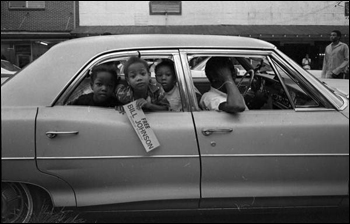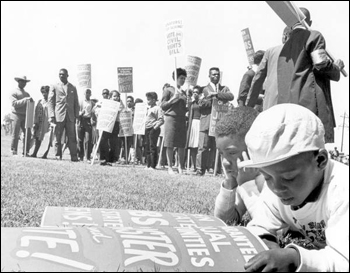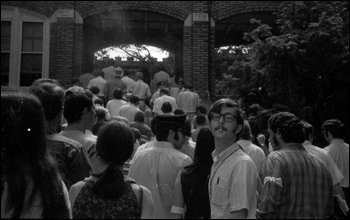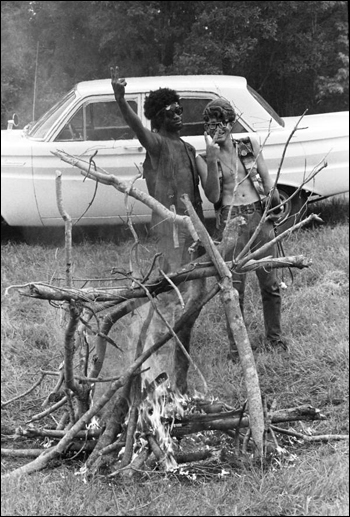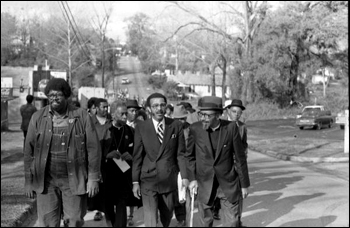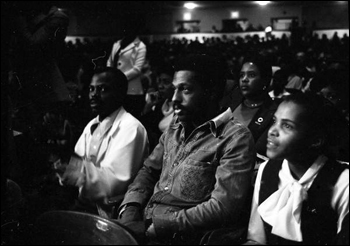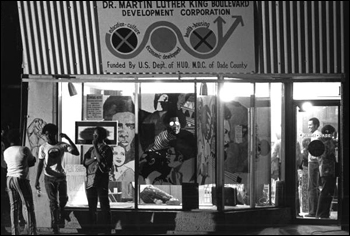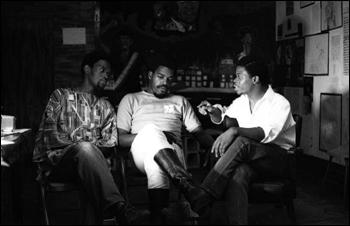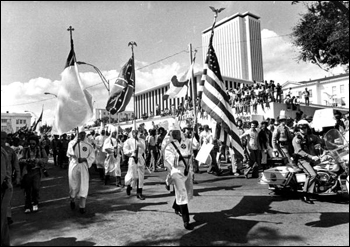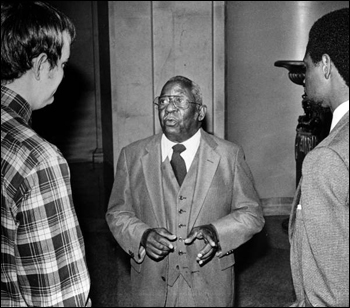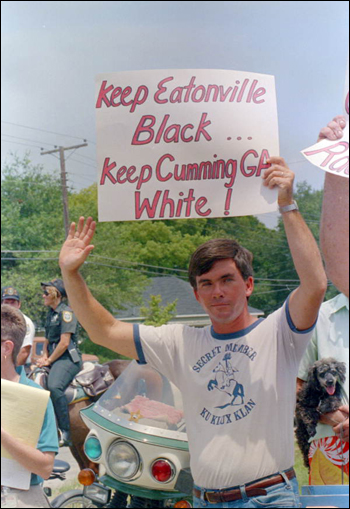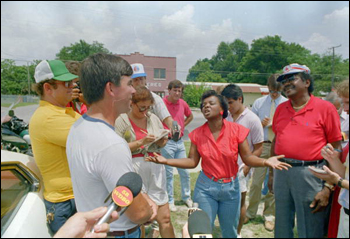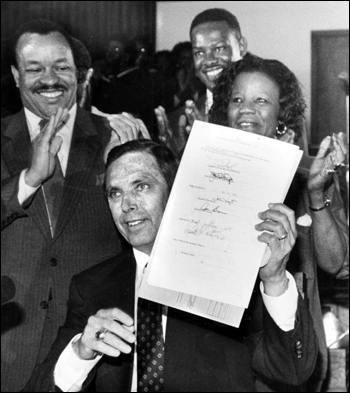Photo Exhibits
Photo exhibits spotlight various topics in Florida history, and are accompanied by brief text intended to place selected materials in historical context.
Racism and the Struggle for Civil Rights in Florida
After the Civil Rights Act of 1964--Approaching Today
The Civil Rights Act was passed in 1964, nearly 100 years after the end of the Civil War. The Act outlawed unequal application of voter registration requirements and racial segregation of public spaces. The combination of the Brown v. Board of Education decision, the Civil Rights Act of 1964, and the Voting Rights Act of 1965 ended the 89-year reign of Jim Crow.
Unidentified children holding a "Free Bill Johnson political prisoner" bumper sticker at rally in Frenchtown: Tallahassee, Florida (July 31, 1971)
Image number: JB00150
Photo author: John Buckley
Scene from the NAACP march in Tallahassee, Florida (196-)
Image number: RC12425
View showing Florida State University students during the Free Sandford rally: Tallahassee, Florida (1969)
Image number: JB00003
Accompanying note: "FSU students demonstrating for the release of Phil Sandford, a graduate student and activist from Australia."
He was arrested on May 13, 1969, for charges of disorderly conduct and interfering with police officers. Sentenced to 18 months, Sandford was ultimately deported, a historically common method for getting rid of radicals.
Photo author: John Buckley
Young men at the 1970 Florida Folk Festival giving the peace/victory sign: White Springs, Florida (1970)
Image number: JB00555
Photo author: John Buckley
Racial discrimination was finally being outlawed, but relieving American society of the burden of its racist heritage remained an ongoing struggle. Lasting changes in African-American life were slow to appear, and economic degradation worsened in African-American communities across the nation. Some civil rights activists became radicalized amidst the turbulent political climate of the 1960s and 1970s. Meanwhile, white supremacist groups remained active as well, despite the historic achievements of the Civil Rights Movement in the United States.
Tallahassee Civil Rights March (1971)
Image number: JB00167
Accompanying note: "2nd from left: Rev. David Brooks, Rector of St. Michael and All the Angels Episcopal Church. 3rd from left: Rev. R.N. Gooden, Pastor of St. Mary Primitive Baptist Church. 4th from left: Rev. Charles Kenzie Steele, Pastor of Bethel Missionary Baptist Church and First Vice president of the SCLC under Dr. King."
Reverend Charles Kenzie Steele was born on February 17, 1914 in Bluefield, West Virginia. He moved to Tallahassee in 1952 and started preaching at the Bethel Missionary Baptist Church. Reverend Steele was one of the main organizers of the Tallahassee bus boycott that began in May 1956. He also helped Dr. Martin Luther King, Jr. organize the Southern Christian Leadership Conference in 1957. Reverend Steele died from bone marrow cancer in 1980 at the age of 66 in Tallahassee.
Photo author: John Buckley
View showing audience in auditorium listening to civil rights speakers (ca. 1975)
Image number: JB00365
Speakers at the event included Tallahassee Civil Rights leader Reverend C.K. Steele and Jesse Jackson.
Photo author: John Buckley
Dr. Martin Luther King Center (February 15, 1972)
Image number: PR23519
Accompanying note: "CBS reports."
Portrait of Malcolm X United Liberation Front organizers (Between 1969 and 1976)
Image number: JB00176
At the right is Robert Perkins, Founder and Chair of the Malcolm X United Liberation Front
Photo author: John Buckley
March of the Ku Klux Klan: Tallahassee, Florida (February 1977)
Image number: RC13859
Virgil Hawkins speaks with supporters during recess: Tallahassee, Florida (November 10, 1983)
Image number: PR20629
Accompanying note: "Virgil Hawkins, age 76, Civil Rights pioneer in Florida, talks with supporters during recess of his own Florida Bar disciplinary case before Florida Supreme Court in which he represented himself."
In April 1949 Hawkins and five other African-Americans applied for admission to professional schools at the University of Florida in Gainesville. They were denied on the basis of race, and the NAACP filed a lawsuit. In June 1958, nine years after filing his application, Hawkins sacrificed his own ambition by withdrawing his application for an agreement that other African-Americans would at last be permitted to enroll at the UF Law School. Hawkins earned a law degree elsewhere, but his civil rights activities cost him his license. His license was finally reinstated in December, 1988—six months after his death
Klansman John Baumgardner holds a sign at the Parade: Eatonville, Florida (August 15, 1987)
Image number: MF0274
Retha Nance addressing Klansman John Baumgardner during a demonstration in Eatonville, Florida (August 15, 1987)
Image number: MF0273
Accompanying note: "Parade watcher Retha Nance, center, gives John Baumgardner, grand titan of the Florida Chapter of the Invisible Empire of the Knights of the Ku Klux Klan, left, a piece of her mind Saturday during 100th year celebration festivities for the predominately black town."
Photo author: Mark Foley
The modern civil rights movement is often said to have began in 1954 with the Brown v. Board of Education Supreme Court decision and ended with the death of Martin Luther King, Jr., in 1968. However, the movement did not appear out of thin air. Just as the struggle for civil rights began decades before the most celebrated marches, boycotts, and moments of triumph, its example left an enduring legacy of aspiration and progress toward freedom for all Americans that lives on today.
Governor Robert "Bob" Martinez signing Dr. Martin Luther King Jr. holiday measure into law in Tallahassee, Florida (May 31, 1988)
Image number: DND0650
Accompanying note: "Florida Gov. Bob Martinez holds up a measure he signed into law Tuesday that establishes a state holiday in honor of slain civil rights leader Dr. Martin Luther King, Jr. From the left are: Speaker pro tempore James Burke, (D)-Miami; Rep. Willie Logan, Jr., (D)-Opa Locka; and Sen. Carrie Meek, (D)-Miami, as they applaud the document's signing."

 Listen: The Blues Program
Listen: The Blues Program